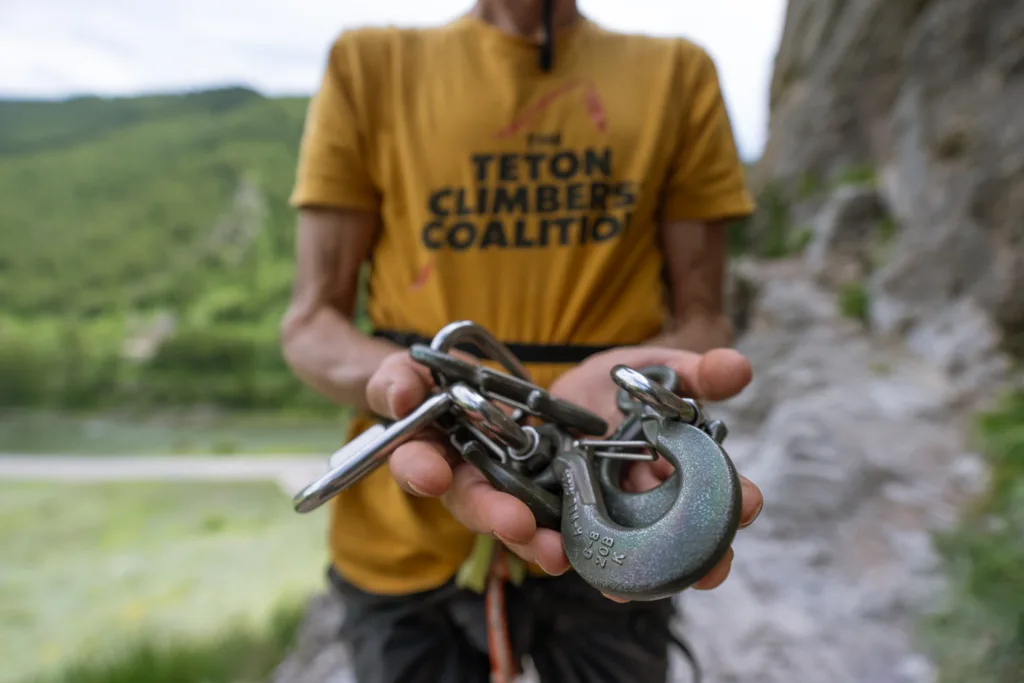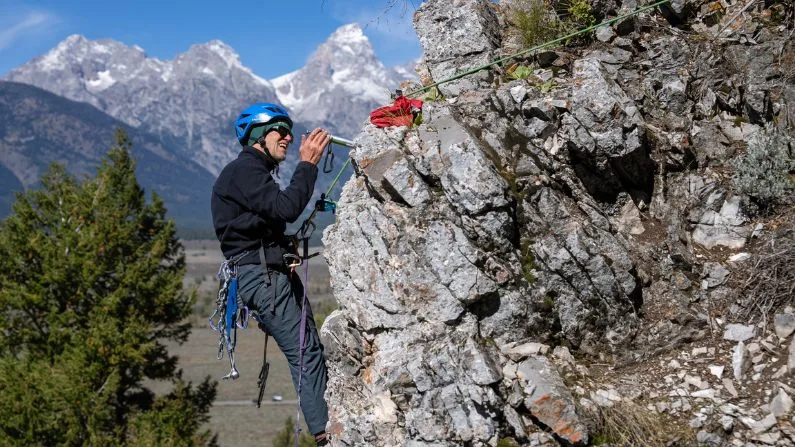Climbers in the Tetons are fighting proposed national regulations they say could change the sport.
Last week, the Teton Climbers’ Coalition became the latest advocacy group to send a letter to federal officials, saying potential guidelines restricting “fixed anchors” in wilderness areas are unsafe, unrealistic and unnecessary.
The new rules — being proposed by the National Park Service and U.S. Forest Service — would allow fixed anchors on a case-by-case basis. That could mean land managers removing some of the metal rings drilled into rocks, or other permanent equipment, that climbers use to lower themselves off of mountains.

Teton Climber’s Coalition board member Charlie Thomas holds the new fixed anchors — known as “mussy hooks” — the group was installing at the Rodeo Wall, a popular sport climbing area. The group is updating the anchors in the region to keep climbers safe. (Chris Anderson)
Popular climbing destinations in the Tetons could be impacted, in addition to the granite peaks in the Wind River Range, since they’re both considered “wilderness.”
“Without fixed anchors, many of the wildest and most inspiring places in America would become inaccessible to the public,” the climbing coalition wrote.
But conservationists say this permanent hardware violates leave no trace principles and the Wilderness Act of 1964. That includes Franz Camenzind, the former executive director of the Jackson Hole Conservation Alliance, who also sent a letter to the federal agencies.
“Why must we surrender the meager Wilderness remaining to a small and very select segment of the population?” Camenzind wrote. “Have we lost all humility and self-restraint?”
An ongoing debate
The proposed rules released in late November are just the latest development in a decades-long debate over the ethics of adding metal hardware to wilderness areas.

The Teton Climbers’ Coalition responded the federal guidance on fixed anchors on Jan. 17. (Screenshot)
Most of these debates revolved around “sport climbing,” where climbers clip their ropes into bolts every couple feet for protection. In sport climbing areas, like Sinks Canyon State Park near Lander, shiny bolts are visible up and down the rock walls to passersby.
But the recently proposed regulations could also impact “traditional climbing” — or “trad” — the primary form of climbing in the Tetons. In this case, climbers carry their own gear to place in the rock for protection as they go.
The only permanent hardware they rely on is often those fixed anchors, which the climbing coalition’s Charlie Thomas said have limited impact.
“Essentially, those are pretty much invisible to anybody who is not doing the climb and not actively looking for them,” said Thomas, a longtime climber.
He said these anchors are often used in emergencies, like when a lightning storm rolls in and climbers need to get to low ground. Removing them, Thomas said, means people would have to look for other ways to get down.
“Which would not only be not safe,” Thomas said. “[But] would also potentially create a much greater impact on the wilderness area, because then people are going to have to create descent trails.”
‘A protective handrail system’
But conservationists like Camenzind say — though exceptions should be made in emergencies — the safety argument holds little weight.

Conservationist Franz Camenzind’s Jan. 16 response to federal guidelines on fixed anchors. (Screenshot)
“If you don’t think something is safe, then you shouldn’t be doing it,” he argued.
Camenzind said he has used fixed anchors before in his work studying wildlife, but doesn’t consider himself a climber.
He compared installing fixed anchors to removing rocks from the Snake River so it’s less dangerous for kayakers, or baseball players bringing the outfield line in so they can hit more home runs.
“Isn’t the wilderness supposed to be a challenge?” Camenzind asked. “It’s supposed to demand your own ability to survive and enjoy it on your own and not have it turn into a protective handrail system.”
But many climbers across the country disagree. For the past year, they’ve been lobbying in Washington, D.C. to protect access. This resulted in U.S. lawmakers, including Senator John Barrasso (R-Wyoming), introducing legislation that would designate climbing an “appropriate recreational use” and specifically allow fixed anchors. Those bills have yet to move forward.
In the meantime, the park service and forest service are accepting comments on their proposed rules through Jan. 30.

Teton Climbers’ Coalition members replace fixed anchors at Blacktail Butte, a popular sport climbing area. The organization replaces and maintains climbing hardware in the region. (Chris Anderson)





